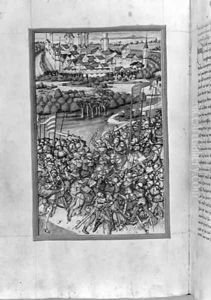Sigismund Meisterlin Paintings
Sigismund Meisterlin, also known as Sigmund Meisterlin, was a German scribe, cartographer, and monk who lived during the 15th century. Born around 1435, his exact date of birth is not documented, but historical evidence places his period of activity in the latter half of the 1400s. Meisterlin is best known for his detailed chronicles and descriptions of cities, which have provided valuable insights into the urban history of Germany during the medieval period.
Entering the Benedictine monastery of St. Ulrich and Afra in Augsburg, Meisterlin took vows as a monk and pursued his scholarly interests within the monastic community. He was not only a religious figure but also an intellectual of his time, engaging in the humanistic pursuits that were becoming increasingly popular during the Renaissance.
Meisterlin's most renowned work is his 'Chronik von Augsburg' (Chronicle of Augsburg), written around 1457, which provides a rich description of the city's history, topography, and important buildings. He also wrote a similar chronicle about Nuremberg, 'Chronik von Nürnberg' (Chronicle of Nuremberg), which remains an important source for the study of that city's medieval history. His works are characterized by their meticulous attention to detail and a blend of factual reporting with myth and legend, reflecting the historiographical methods of the time.
Meisterlin's contributions extend beyond his chronicles. He was also involved in the production of maps, and his cartographic work is notable for its early attempts to accurately represent urban spaces. His maps were not only functional but also served as a form of visual expression that complemented his written accounts.
Although much of Meisterlin's life remains shrouded in mystery, his legacy endures through his written and cartographic works. The exact date of his death is not precisely known, but it is generally believed that he passed away around 1495. Meisterlin's chronicles continue to be studied by historians and art historians for their rich narrative and the unique perspective they offer on the cities of Augsburg and Nuremberg during the late medieval period.
